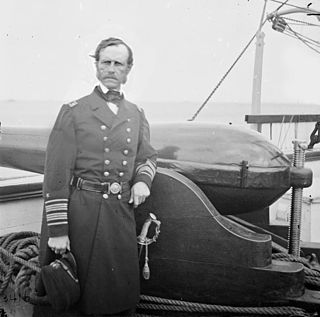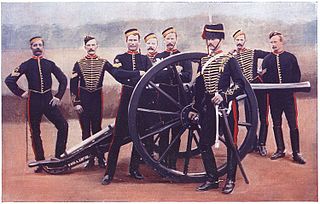Design
The idea behind a gun that could fire spherical exploding shells but not solid armour-piercing shot was that large projectiles capable of carrying a large explosive filling could be fired from comparatively light guns: [8] the 8-inch 68 pounder gun intended to fire solid shot weighed 95 cwt (4,826 kg) compared to the 65 cwt (3,302 kg) of the typical 8-inch shell gun.
This was a "chambered" gun, meaning that the area at the breech-end of the gun where the gunpowder propellant charge burned was not of the same cylindrical section as the gun bore itself. The chamber was of the "Gomer" conical pattern, tapering towards the rear, typical of mortars of the day. This was necessitated by the need to minimise the gun's weight while still allowing it to fire a relatively heavy shell : it ensured that the thickest amount of metal surrounded the point of maximum pressure on firing, at the rear of the chamber. However, mortars fired at high elevations, allowing the powder charge to naturally seat into the coned rear end of the chamber, whereas guns such as this fired on a relatively flat trajectory, leading to the powder charge sitting on the bottom of the chamber. Hence in sea service using smaller "reduced" charges such as in short-range actions this slowed the rate of fire as precautions had to be taken to ensure that the powder charge remained correctly positioned within the chamber until firing, to avoid a misfire. [9]
A muzzleloader is any firearm into which the projectile and the propellant charge is loaded from the muzzle of the gun. This is distinct from the modern designs of breech-loading firearms. The term "muzzleloader" applies to both rifled and smoothbore type muzzleloaders, and may also refer to the marksman who specializes in the shooting of such firearms. The firing methods, paraphernalia and mechanism further divide both categories as do caliber.

A shell is a projectile whose payload contains an explosive, incendiary, or other chemical filling. Originally it was called a bombshell, but "shell" has come to be unambiguous in a military context. Modern usage sometimes includes large solid kinetic projectiles that is properly termed shot. Solid shot may contain a pyrotechnic compound if a tracer or spotting charge is used.

The Paixhans gun was the first naval gun designed to fire explosive shells. It was developed by the French general Henri-Joseph Paixhans in 1822–1823. The design furthered the evolution of naval artillery into the modern age. Its use presaged the end of wood as the preferred material in naval warships, and the rise of the ironclad.

A rifled breech loader (RBL) is an artillery piece which, unlike the smoothbore cannon and rifled muzzle loader (RML) which preceded it, has rifling in the barrel and is loaded from the breech at the rear of the gun.

Dahlgren guns were muzzle-loading naval artillery designed by Rear Admiral John A. Dahlgren USN, mostly used in the period of the American Civil War. Dahlgren's design philosophy evolved from an accidental explosion in 1849 of a 32 lb (14.5 kg) gun being tested for accuracy, killing a gunner. He believed a safer, more powerful naval cannon could be designed using more scientific design criteria. Dahlgren guns were designed with a smooth curved shape, equalizing strain and concentrating more weight of metal in the gun breech where the greatest pressure of expanding propellant gases needed to be met to keep the gun from bursting. Because of their rounded contours, Dahlgren guns were nicknamed "soda bottles", a shape which became their most identifiable characteristic.

Naval artillery is artillery mounted on a warship, originally used only for naval warfare and then subsequently used for shore bombardment and anti-aircraft roles. The term generally refers to tube-launched projectile-firing weapons and excludes self-propelled projectiles such as torpedoes, rockets, and missiles and those simply dropped overboard such as depth charges and naval mines.
This article explains terms used for the British Armed Forces' ordnance and also ammunition. The terms may have slightly different meanings in the military of other countries.

The Armstrong RBL 7-inch gun, also known as the 110-pounder, was an early attempt to use William Armstrong's new and innovative rifled breechloading mechanism for heavy rifled guns.

Naval artillery in the Age of Sail encompasses the period of roughly 1571–1862: when large, sail-powered wooden naval warships dominated the high seas, mounting a bewildering variety of different types and sizes of cannon as their main armament. By modern standards, these cannon were extremely inefficient, difficult to load, and short ranged. These characteristics, along with the handling and seamanship of the ships that mounted them, defined the environment in which the naval tactics in the Age of Sail developed.

The Ordnance BL 6 inch 30cwt howitzer was a British medium howitzer used in the Second Boer War and early in World War I. The qualifier "30cwt" refers to the weight of the barrel and breech together which weighed 30 hundredweight (cwt) : 30 × 112 lb = 3,360 lb. It can be identified by the slightly flared shape of the muzzle and large recuperator springs below the barrel.

The Ordnance BL 15-pounder, otherwise known as the 15-pounder 7 cwt, was the British Army's field gun in the Second Boer War and some remained in limited use in minor theatres of World War I. It fired a shell of 3-inch diameter with a maximum weight of 15 pounds (6.8 kg), hence its name which differentiated it from its predecessor '12-pounder' 3-inch gun which fired shells weighing only 12.5 pounds (5.7 kg).

The Ordnance BL 12-pounder 7cwt was the British Army's field gun, which succeed the RML 13-pounder 8 cwt in 1885.

The BL 6-inch gun Marks II, III, IV and VI were the second and subsequent generations of British 6-inch rifled breechloading naval guns, designed by the Royal Gun Factory in the 1880s following the first 6-inch breechloader, the relatively unsuccessful BL 6-inch 80-pounder gun designed by Elswick Ordnance. They were originally designed to use the old gunpowder propellants but from the mid-1890s onwards were adapted to use the new cordite propellant. They were superseded on new warships by the QF 6-inch gun from 1891.

The Armstrong Breech Loading 20-pounder gun, later known as RBL 20-pounder, was an early modern 3.75-inch rifled breech-loading light gun of 1859.

The RML 64-pounder 71 cwt guns (converted) were British rifled muzzle-loading guns converted from obsolete smoothbore 8-inch 65 cwt shell guns in the 1860s-1870s.

The BL 6-inch 80-pounder gun Mk I was the first generation of British 6-inch breechloading naval gun after it switched from muzzle-loaders in 1880. They were originally designed to use the old gunpowder propellants.

The 68-pounder cannon was an artillery piece designed and used by the British Armed Forces in the mid-19th century. The cannon was a smoothbore muzzle-loading gun manufactured in several weights, the most common being 95 long cwt (4,800 kg), and fired projectiles of 68 lb (31 kg). Colonel William Dundas designed the 112 cwt version in 1841 and it was cast the following year. The most common variant, weighing 95 cwt, dates from 1846. It entered service with the Royal Artillery and the Royal Navy and saw active service with both arms during the Crimean War. Over 2,000 were made and it gained a reputation as the finest smoothbore cannon ever made.

The RML 13-pounder 8 cwt gun was a British Rifled, Muzzle Loading (RML) field artillery gun manufactured in England in the 19th century, which fired a projectile weighing approximately 13 pounds (5.9 kg). "8 cwt" refers to the weight of the gun.

The 32-pounder guns were sets of heavy-caliber pieces of artillery mounted on warships in the last century of the Age of sail.

The 10-pounder Parrott rifle, Model 1861 was a cast iron muzzle-loading rifled cannon that was adopted by the United States Army in 1861 and often used in field artillery units during the American Civil War. Like other Parrott rifles, the gun breech was reinforced by a distinctive wrought iron reinforcing band. The gun fired a 9.5 lb (4.3 kg) projectile to a distance of 1,850 yd (1,692 m) at an elevation of 5°. The 10-pounder Parrott rifle was capable of firing shell, shrapnel shell, canister shot, or solid shot. Midway through the war, the Federal government discontinued the 2.9 in (74 mm) version in favor of a 3.0 in (76 mm) version. Despite the reinforcing band, the guns occasionally burst without warning, inflicting injury on the gun crews. The Confederate States of America manufactured a number of successful copies of the gun.

















